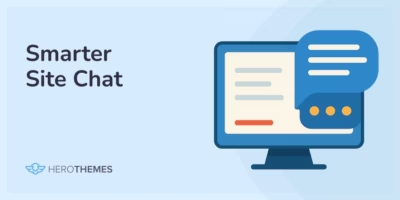Missive Review 2025: A Worthy Shared Inbox for Small Businesses
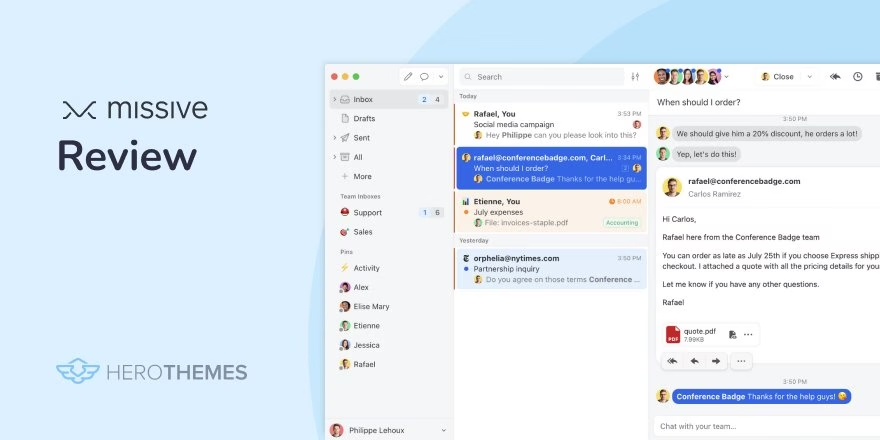
Today, 25,000+ users across 4,000+ companies rely on Missive for their daily operations, from small businesses and startups to customer support and marketing teams.
In this review of Missive, I will test how this help desk software can streamline your customer service tasks in 2025, and whether it is suitable for your business and team.
In This Guide
Missive Company Background and Evolution
Missive is an all-in-one team inbox and communication tool designed to help teams collaborate around email and other messages. It combines a shared email inbox with built-in chat, tasks, and automation, allowing businesses to handle customer communications and internal discussions in one place.
Originally launched in 2015 by a small team in Quebec, Canada, Missive’s mission has been to “work smarter together” by redefining how teams manage emails and conversations.
Missive was born out of the founders’ own struggle managing customer support.
They wanted a way to keep work and internal collaboration in the inbox, alongside client emails.
Since the launch, Missive has steadily expanded its capabilities. Especially recent updates have been particularly impactful:
- In 2023, Missive launched AI-powered email assistance, to help users draft replies, summarize threads, and translate messages.
- In early 2025, Missive introduced AI-driven automation rules
Through all these changes, Missive has maintained a focus on empowering small teams: as CEO Philippe Lehoux puts it,
“Your local car repair shop probably uses Missive – so does a fancy tech company… we want everyone to enjoy their inbox”.
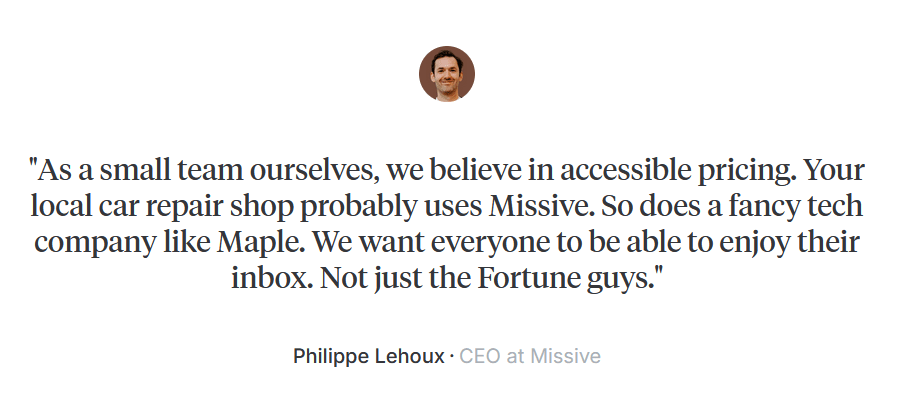
Missive Review Quick Summary
With this review, I found Missive to be a mature and well-rounded solution for help desk teams. It’s clear that the product is crafted with a lot of attention to detail. Many small conveniences in Missive show the team’s own experience in needing such a tool.
Is there room for improvement? Certainly. The team could refine things like the search speed, perhaps simplify onboarding for new users, and continue adding integrations as new popular tools emerge. But none of the current shortcomings are deal-breakers for audiences Missive targets.
I will rate Missive: ★★★★☆ (4/5) – Highly recommended for help desk teams looking for a SaaS solution.
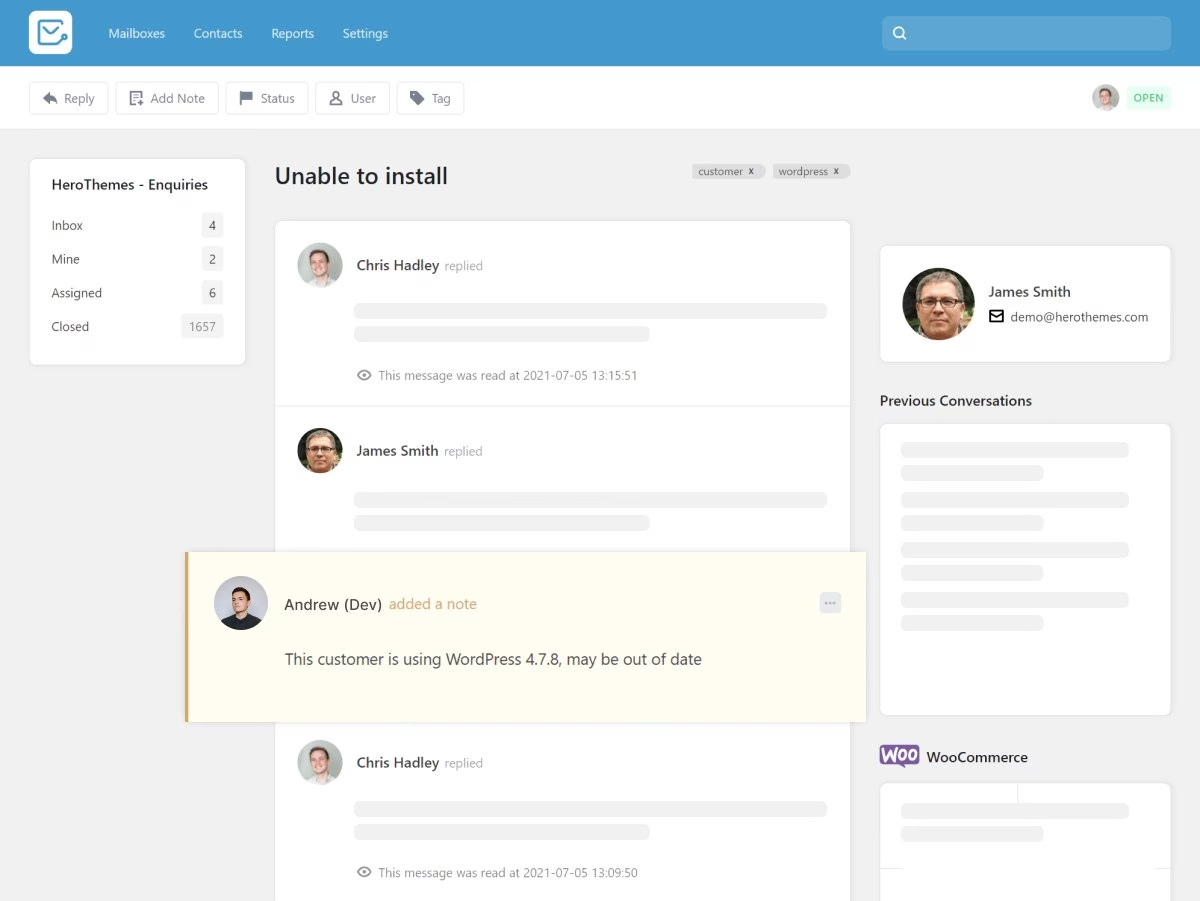
Heroic Inbox
A simple and affordable helpdesk for small businesses.
All plans include unlimited users and tickets.
Like any software, Missive has its strengths and areas for improvement. Here’s a balanced look at the overall pros and cons (be sure to read the complete review for more information):
Pros:
- Unified communication hub
- Excellent collaboration features
- Integrated task management
- Powerful automation and AI
- Ease of use (after onboarding)
- Responsive support and active development
- Cross-platform and integration-friendly
- Secure and business-ready
- Value for money
Cons:
- Initial learning curve
- Search Performance for Email
- Limited voice/channel support
- Fewer native integrations than some rivals
- The mobile app is full-featured but could feel busy
- Minor quirks in permissions
- Design is functional (Not a “Sexy” app)
It’s worth emphasizing that most cons are relatively minor or situational, and the Missive team has a track record of addressing issues over time.
Missive Review 2025

We rigorously test and research every product that we recommend through HeroThemes. Our review process. We may also earn a commission if you make a purchase through our links.
From time-to-time Missive team has proven their commitment towards creating better help desk software, and working on customers’ feedback.
Now, on to the actual review of Missive’s features, pricing, and other components that make great software.
1. User Interface and Experience Review
Missive’s user interface will feel familiar to anyone who has used a modern email client, with a clean three-pane layout (mailboxes, message list, and message content) augmented by team collaboration tools.
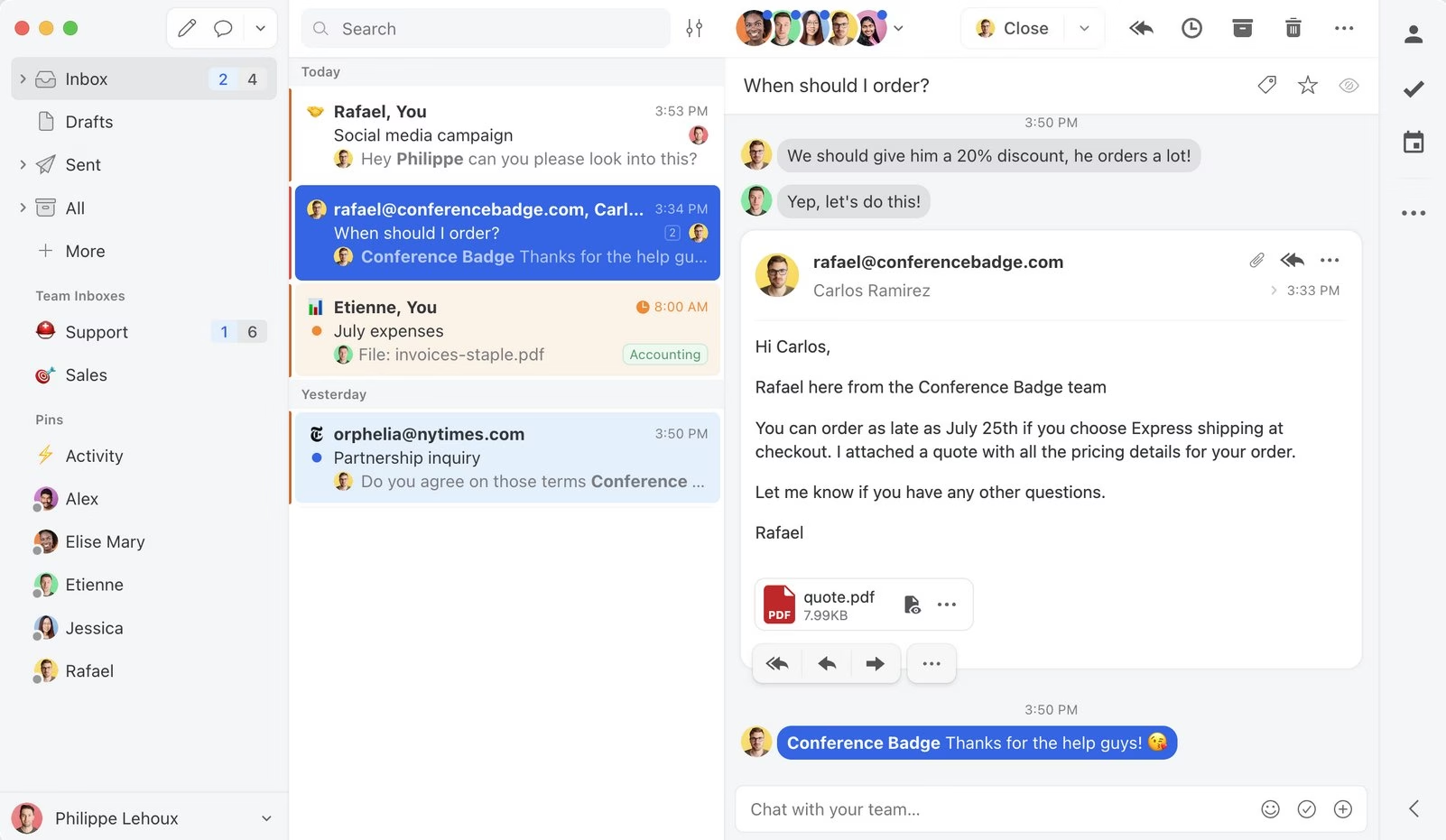
Overall, the UI is clean and efficient rather than flashy, prioritizing function over form. You can switch between light, dark, or mixed themes, and the layout is customizable with options like conversation threading, split-pane view, and keyboard shortcuts (it even supports Gmail’s shortcut scheme for veteran users).
Now to the user experience part where Missive really shines:
- Team members can start an internal chat directly alongside an email. For example, a support agent can @mention a colleague with a question or add a comment with suggestions. This kind of approach keeps everyone on the same page without endless CCs or external Slack messages.
- You can assign a conversation to a teammate or to yourself with one click.
- Indicators show when someone is replying or has read a message, preventing duplicate work.
- The interface supports familiar actions like drag-and-drop for attachments, email snoozing (to remind you later), send later scheduling, and even “Send & Archive” in one button.
- Power users will appreciate features like message templates (canned responses with variables) for quick replies and the ability to undo send an email within a grace period.
- Built-in calendar for handling event invites and scheduling, and an emoji picker and rich text formatting in chats for a bit of personality.
- Cross-platform support is strong: Missive has desktop apps for Windows and macOS, mobile apps for iOS and Android, and a full-featured web app.
Learning curve
If there’s one caveat to the UX, it’s that Missive is rich in features, which can feel overwhelming at first.
New users may need a little time (and perhaps a glance at the helpful tutorial videos) to fully understand concepts like rules, teams, and shared labels.
2. Key Features and Capabilities Review
Missive has hundreds, if not thousands of features. Instead of covering them all, let’s focus on the important ones that most support teams need.
Shared Inbox and Email Collaboration
At its core, Missive provides shared inboxes that let teams work together on email.
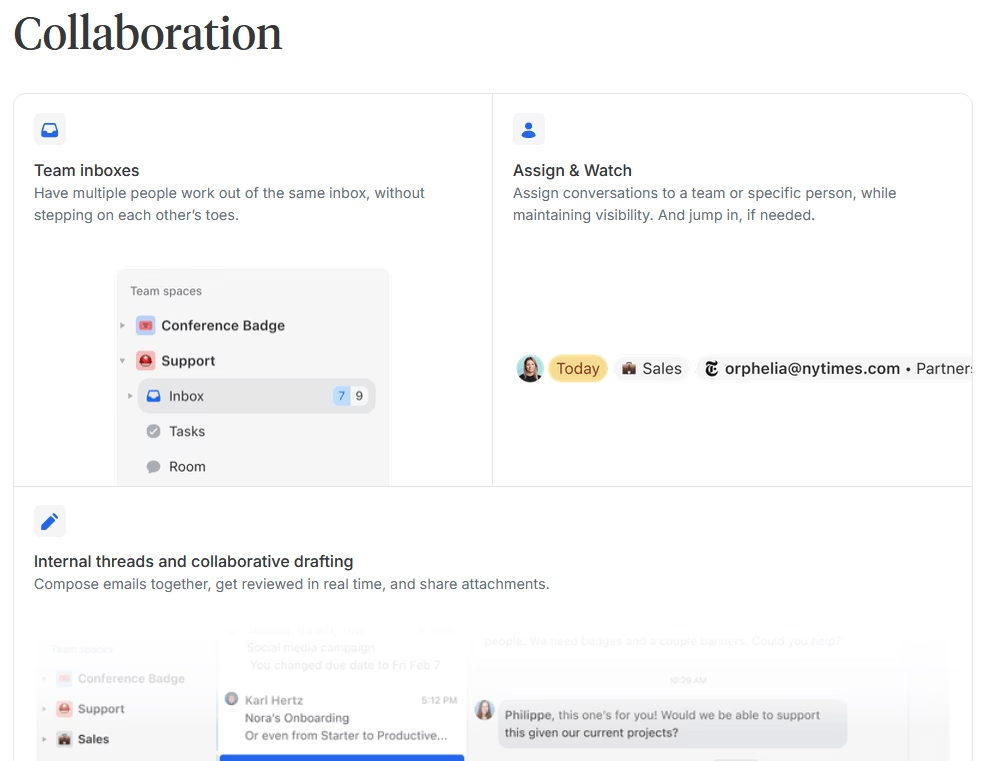
You can connect email accounts from any provider (Google, Office 365, iCloud, IMAP, etc.) and then share those accounts or specific email addresses with your team.
For example, a support team might share the address support@yourcompany.com so that all incoming emails are visible to the group.
With a shared inbox, team members can use benefits from features like:
- Internal threads (chat comments)
- Collaborative drafting
- Standalone team chat rooms for more general discussions
- Member assignments and watchers
- Internal status labels
Importantly, Missive’s collaboration features are designed to keep email workflows natural.
In practice, Missive helps break down silos, as every relevant team member can access a conversation, so knowledge isn’t confined to one person’s mailbox. Which can be a huge advantage for keeping everyone in the loop and responding faster to customers.
Tasks and Workflow Management
One standout feature that sets Missive apart from many email tools is its integrated task management.
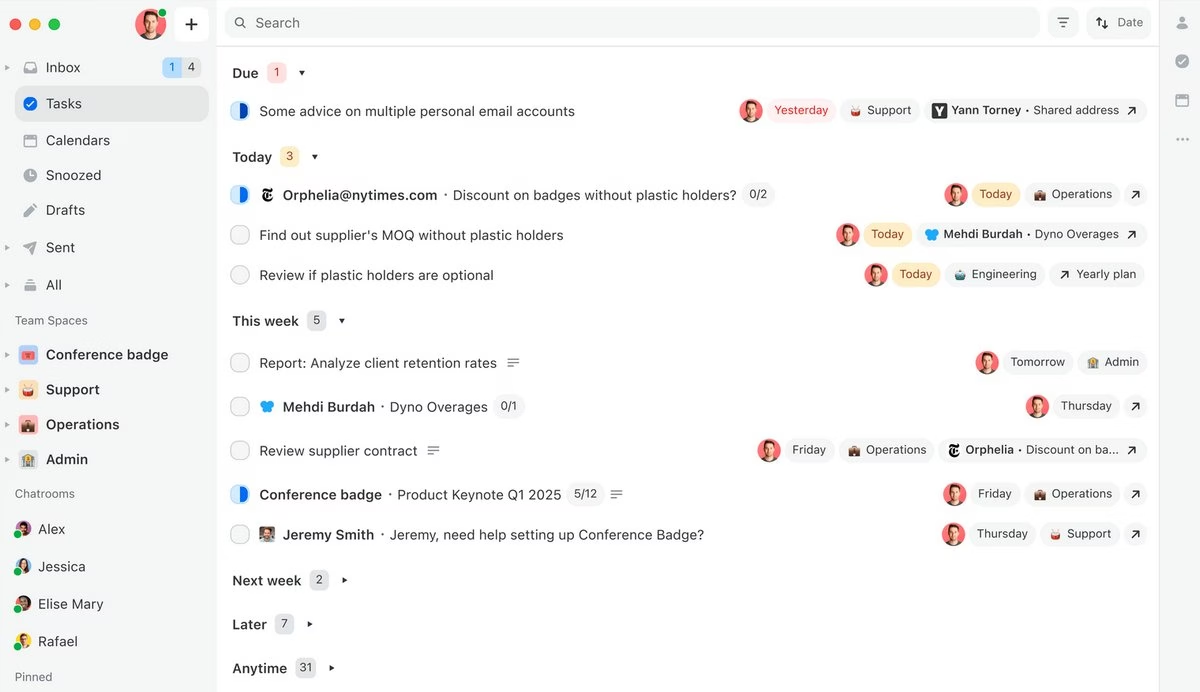
The philosophy here: if your inbox often doubles as a to-do list, why not make it truly work like one?
Missive allows you to turn any email into a task with a simple press of T, linking it to that conversation.
You can also create standalone tasks (not tied to an email) for general to-dos:
- Tasks can be assigned to teammates
- Given due dates
- Organized into sections like To Do, In Progress, and Done.
I found this feature is incredibly useful for managing follow-ups and internal action items.
For personal productivity, you can use tasks to keep track of your own email to-dos (like “Reply by Friday” or “Prepare quote before call”), integrating GTD principles right into your inbox.
Teams, on the other hand, can use Missive’s tasks to allocate workload.
The collaborative task features have made Missive a more comprehensive work tool. It’s not trying to replace full-scale project management software, but for many common business workflows. Especially those that start or end as an email.
As the Missive team says,
“Your inbox is finally becoming what it should have been all along: a clear, organized command center where email and tasks blend seamlessly”.
Integrations and Multi-Channel Messaging
Modern communication isn’t just email, and Missive recognizes that. The platform supports a wide range of messaging channels and app integrations, making it a centralized hub for all customer conversations.
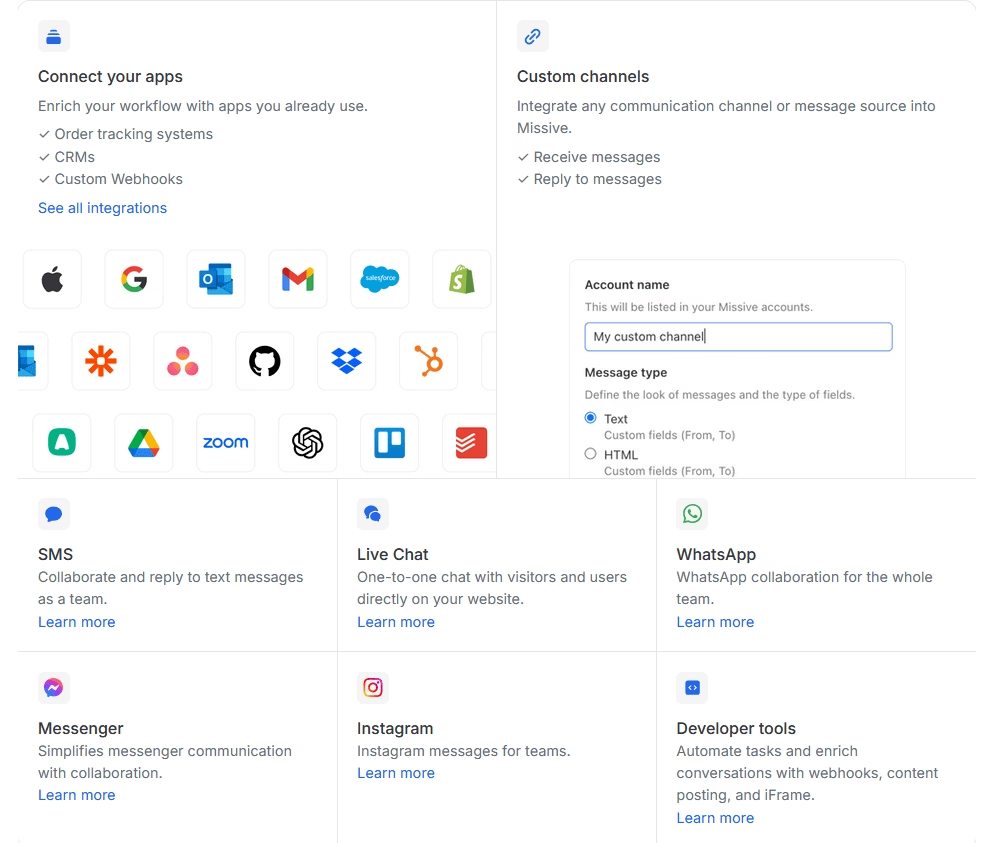
Out of the box, Missive can handle emails, SMS text messages, WhatsApp chats, and social media messages in one unified inbox.
This omnichannel support is a huge plus for customer-facing teams. A support agent could be replying to an email from a customer, then quickly answer a Facebook Messenger question, then an SMS – all within the same app and with the same collaboration tools (internal comments, assignments, etc.), so you don’t have to juggle separate apps or logins.
For small businesses that communicate with clients on various channels, this consolidation saves time and ensures nothing gets overlooked.
One thing to note: while Missive covers all major channels and has many integrations, it may have fewer built-in integrations than some larger help desk platforms (which might offer 100+ integrations or a plugin marketplace). Missive focuses on communication channels and productivity apps; it does not natively include a voice/telephony channel or video calls, so it’s not a call center solution.
Automation and AI Features
Missive offers powerful automation and AI capabilities.
The Rules feature acts like supercharged email filters: you can create custom rules that trigger on incoming or outgoing messages (across all channels) and define actions to happen automatically.
For example, you might set a rule: “If an email to support@ contains the word ‘refund’, assign it to the Billing team and apply a ‘Urgent’ label.” Or “When an email from a VIP client arrives, notify a specific channel and snooze it for 1 hour if not replied.”
The possibilities are endless.
A partnership with OpenAI allows Missive to offer AI writing assistance and analysis directly in the app. Some handy AI features include:
- Instant AI Drafts
- One-click Summarize Conversation
- Translate
- Users design and save their own custom AI prompts
- AI-driven rules (Autopilot) feature
This kind of intelligent automation is cutting-edge and can significantly reduce triage time for busy inboxes.
All these AI features require an OpenAI API key on your end. Missive doesn’t charge extra; you use your own key to enable AI, keeping costs transparent.
Reporting and Analytics
For team managers, Missive includes a basic analytics dashboard, with more advanced reporting in higher tiers.
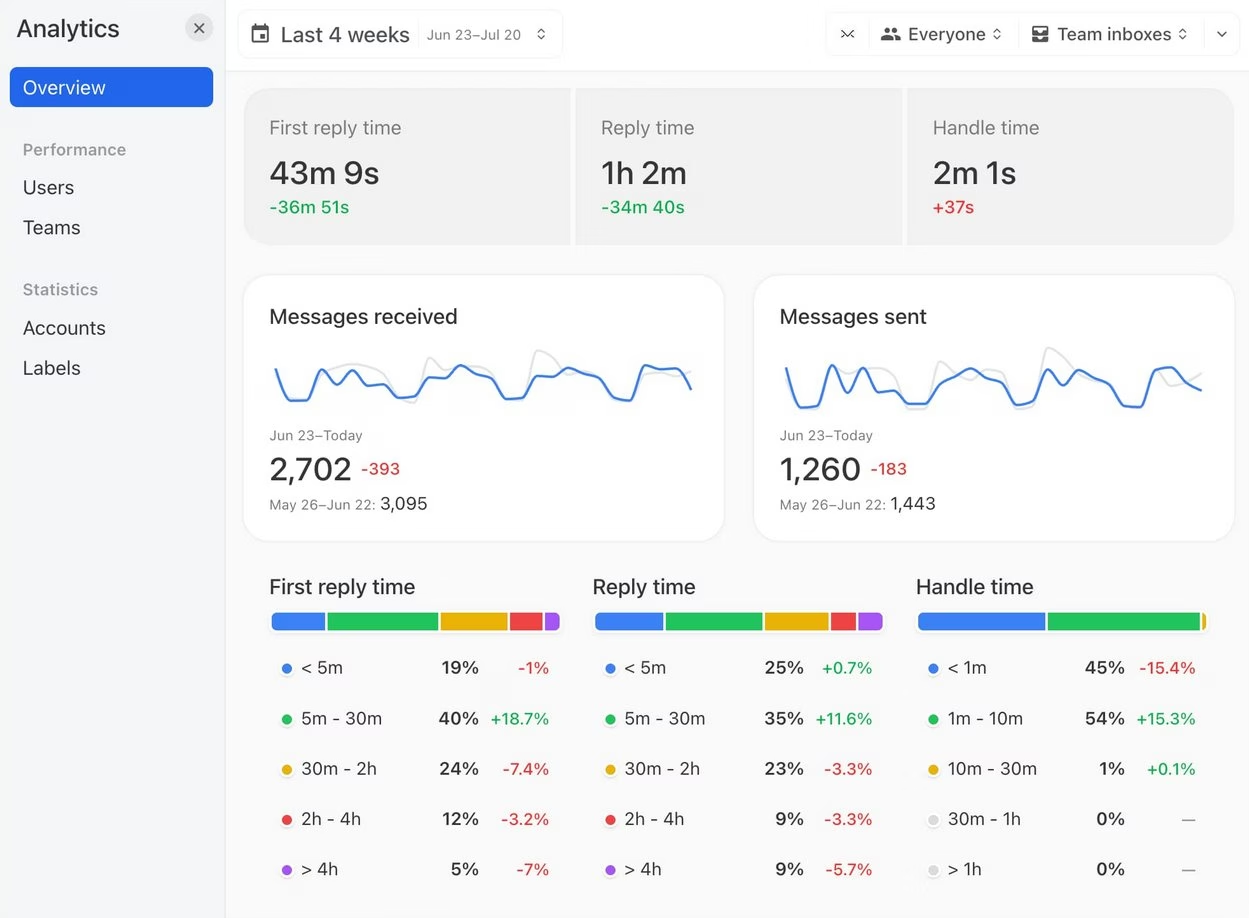
You can track metrics like:
- Response times
- Conversation volumes
- Handle time
Combined with Missive’s assignment and tags, managers can also manually review how conversations are distributed and how quickly they’re resolved.
For many small businesses, these built-in analytics are sufficient to keep customer service quality high. And because Missive logs every action in an audit trail (like who archived an email, who merged conversations, etc.), you have transparency and traceability if needed.
3. Scalability and Use Cases
Missive is built to scale with your team, whether you’re a solo user, a small team, or a growing organization. One of its strengths is that it doesn’t force a one-size approach. It’s flexible enough to adapt to different workflows.
Missive for Freelancers and Solo Professionals
Surprisingly, even individual users can benefit from Missive.
If you manage multiple email accounts or wear many hats, Missive lets you unify everything in one inbox and use its powerful features to stay organized.
Solo users can snooze messages, set reminders, and use rules to automate personal workflows (e.g., label all emails from a certain client, or remind you in 3 days if an important email hasn’t been answered).
The internal chat features might go unused if you’re alone, but many solos still appreciate Missive as a productivity-focused email client.
In fact, some users have replaced Gmail or Outlook with Missive purely for its interface and features, even if they aren’t collaborating with others.
Missive for Small Teams and Startups
This is Missive’s sweet spot. For teams of 2 to ~20, Missive provides a very cost-effective and robust solution to handle group email addresses (like info@, support@, sales@) and to collaborate on client communications.
Small businesses often need to juggle customer support, sales inquiries, and internal approvals with limited staff. Missive enables them to do this without investing in a heavyweight help desk system.
Missive’s affordability (including a free tier for up to 3 users) and intuitive design make it very suitable for small business needs. Whether it’s a customer support team, a marketing team managing partnerships, or even a real estate agency coordinating inquiries, Missive fits naturally into workflows where a team needs to collectively manage communications.
Missive for Medium-Sized Teams
As organizations grow into dozens of users, Missive can still scale to meet their needs. The Productive plan supports up to 50 users per workspace, and you can even create multiple organizations within Missive if you have different divisions.
Medium-sized companies often appreciate Missive’s more advanced features like API access, integrations with CRM/project tools, and analytics to monitor team performance.
Missive for Large Organizations
For enterprise-scale use (hundreds of users, multiple departments), Missive can be used but with some considerations.
The Business plan allows unlimited users and offers SSO/SAML integration, which is crucial for enterprise IT management.
For most large enterprises, Missive would be considered “less suitable” as a full helpdesk replacement.
However, it remains an excellent complementary tool even in big organizations. For example, handling internal email delegation among executives and assistants, or managing certain shared accounts with high collaboration needs.
4. Customer Support and Documentation
Missive has garnered an outstanding reputation for its customer support.
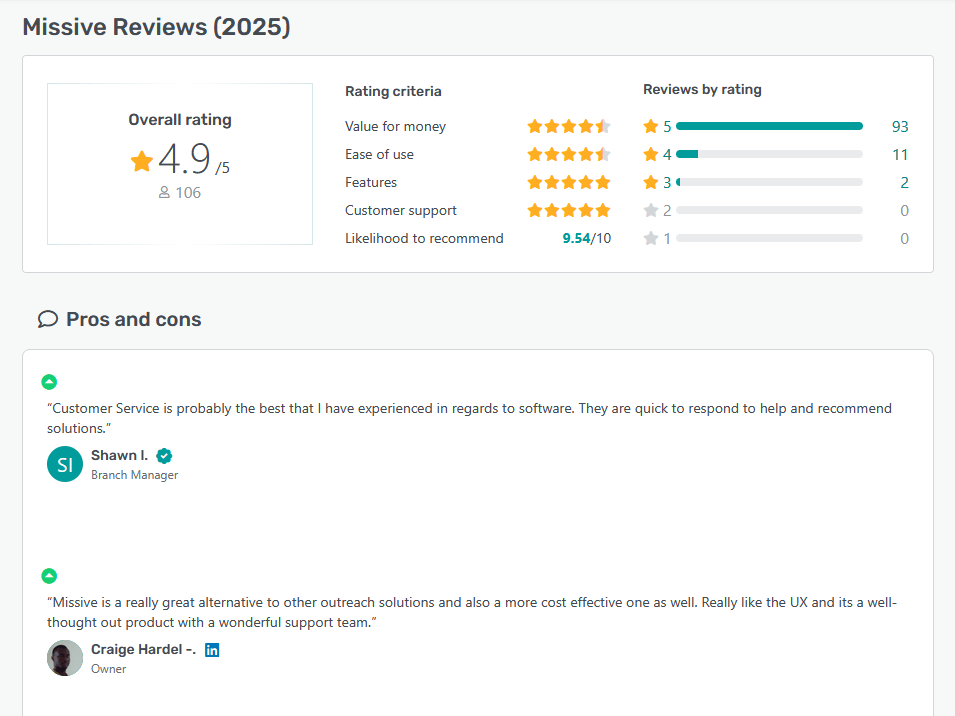
Users consistently praise the Missive support team for being responsive, helpful, and truly listening to feedback.
This level of support is a major plus, especially when adopting a tool that’s critical to your daily workflow. It’s clear that Missive’s team cares about its customers’ success.
- Support is available through email and chat (via the Missive app itself)
- Users often get replies within a few hours or faster during business times.
- There is no phone support, but given the efficiency of their email/chat help and the thoroughness of their documentation, most users don’t miss it.
- Missive provides an extensive online documentation with how-to guides, FAQs, and even feature-specific tutorials.
Missive’s commitment to support is further seen in their frequent release cycle. They actively fix bugs and roll out improvements (the public changelog shows updates every few weeks with new features or fixes).
In summary, Missive backs up its software with top-tier customer support and resources. This can give small businesses peace of mind. You’re not just getting a tool, but a responsive team behind it.
5. Pricing: Plans and Value for Money
One of Missive’s attractive qualities is its transparent and flexible pricing, especially compared to many competitors.
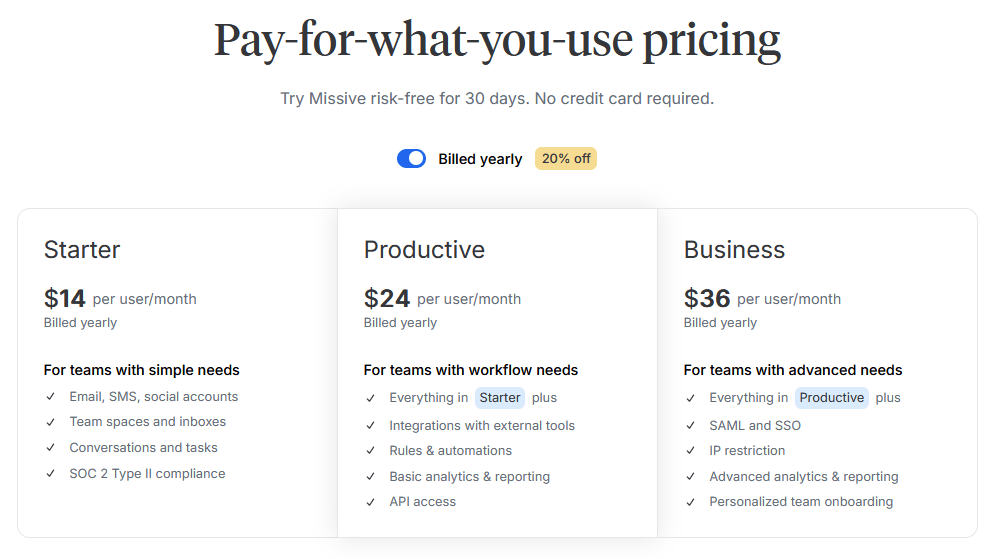
There is a Free forever plan that allows up to 3 users in an organization, with some limitations of course.
For more serious use, Missive offers three paid plans (as of 2025):
- Starter – $18/user per month (or $14/user billed annually): This tier is for small teams “with simple needs”. It supports up to 5 users per workspace with all the standard Missive features.
- Productive – $30/user per month (or $24/user billed annually): This is the most popular plan, aimed at teams “with workflow needs”. The Productive plan supports up to 50 users in an organization. For most small and medium businesses, this tier hits the sweet spot.
- Business – $45/user per month (or $36/user billed annually): This tier is designed for organizations with advanced needs or larger scale. Companies would go with this if they require SSO or have more than 50 users on Missive.
Missive’s pricing is simple and predictable. There are no add-on fees for extra channels or a la carte features, and you’re not forced into higher tiers unless your team size or feature needs truly demand it.
Compared to many competitors (such as Zendesk, Front and Help Scout) in the customer communication space, Missive is notably affordable.
For instance, Front (a popular shared inbox software) does not offer a free plan and its plans start around $59/user for basic features, going up to $229/user for enterprise.
Of course, value is not just about price – it’s price relative to benefit. And here users tend to agree that Missive punches above its weight. Teams get a professional, secure, and feature-rich platform that can replace or reduce reliance on multiple other tools (email client, Slack, task manager, etc.).
That said, you should consider what features they truly need. If you don’t need the collaborative elements, a free email client might suffice.
Missive’s pricing structure, combined with its capabilities, makes it one of the best value collaboration inbox platforms on the market in 2025. It democratizes access to advanced team email tools. Even a small business or a solo freelancer can afford to use Missive and reap the productivity benefits.
Final Thoughts on Missive
Missive has carved out a unique niche as a platform that blends the familiarity of email with the collaboration of modern messaging apps. In doing so, it addresses a pain point felt by many organizations: email is critical for work, yet traditional email was never built for teams.
Missive turns email into a team sport, eliminating the silos and friction that often come with managing group inboxes or forwarding threads around for input.
Overall, Missive is an ideal choice for teams who “run on email” and want to do so more collaboratively and efficiently.
That’s what I think.
What do you think about Missive? Share your thoughts in the comments below!
Further Reading
8 Help Scout Alternatives: Best Budget-Friendly Help Desk Solutions
9 Best Knowledge Base Software (2025 Guide)
11 Best Remote Support Software for 2025 (Mostly Free)
9 Best Customer Service Software for Any Business (2025 Guide)
10 Best Practices to Improve Help Desk Support
Zoho Desk Review 2025: Powerful Yet Affordable!



